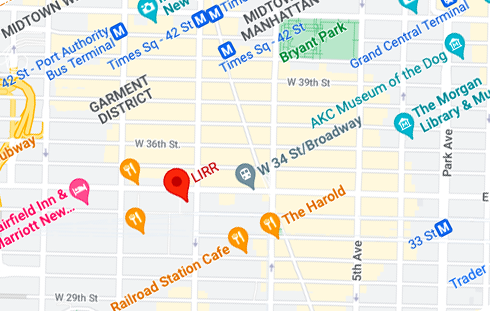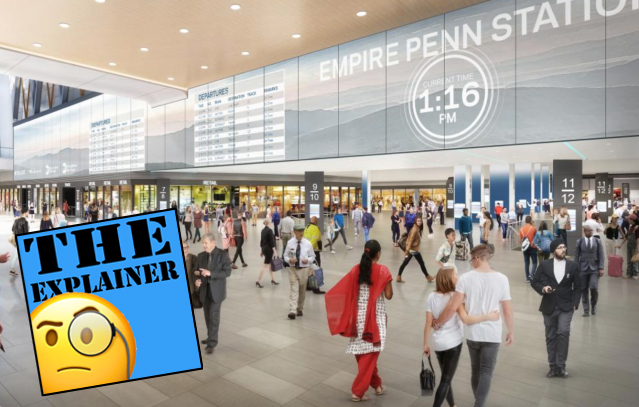
For years, New York governors have dreamed of a big infrastructure project that would undo the pain (and traveling trauma) done by the destruction of the original Penn Station — which was the Day the Music Died for transportation nerds. Today, the usually anonymous Public Authorities Control Board is expected to approve a plan to do just that, bringing all those governors' dream one step closer to reality.
So why are so many smart people and groups throwing around words like "corruption" and "handout" and something smelly that "undermines public trust" when discussing the project? Let the Explainer explain it all for you:
So first, what's the plan?
The state wants to remake the Midtown neighborhood around Penn Station by selling development rights that would provide the funds (how much is unclear) for a renovation of the widely hated transit sewer. The plan leaves open the possibility of a future expansion of the train station.
The plan would transform the dark and dingy bi-level station into a single-level station with a huge concourse, high ceilings, more entrances and elevators, and an atrium and skylight. The airy, refurbished station will also have an underground passage to the Herald Square subway station, providing easy connections to the N, Q, R, Q, B, F, D and M trains.
Above ground, the area around Penn Station is supposed to get a new 30,000 square-foot public plaza between West 30th Street and West 31st Street and an improved public plaza on West 33rd Street between Seventh Avenue and Eighth Avenue, both of which basically only exist as renderings now. The surrounding area is also supposed to get wider sidewalks, protected bike lane extensions on Seventh Avenue and Eighth Avenue and on West 31st Street between Sixth Avenue and Ninth Avenue, nine commercial office buildings and 1,800 apartments, including up to 708 rent-regulated and supportive housing units. The new buildings will also have parking spaces, though it's unclear how many parking spaces, something that the plan would have to lay out if done under the usual city zoning auspices.
Wait, 8 acres?

The city considers an acre of open space for 400 residents the bare minimum for dense urban areas, according to its own planning document. Assuming two people per apartment unit, this plan would have roughly an acre of open space for 450 people. That's not enough.
Even the Environmental Impact Statement for the plan admits that the project "is below the city's median community district open space ratio," but, wouldn't you know, it's all OK because the neighborhood "is not considered underserved" (not underserved for open space? See map and you decide for yourself if the area around Penn Station has enough open space).
But everyone hates Penn Station, right?
Yes, everyone hates Penn Station. After all, check out this completely factual propaganda video explaining the plan, which offers almost no images of the proposal, no cost estimates and only some vague promises that taxpayers won't be left holding the bag or end up unsatisfied by the results. (Be sure to watch to the end where very real New Yorkers say the exact things that the government needs them to say in order to make it seem like this is a beloved and popular plan.)
OK, but what's really the plan?
The Pennsylvania Station Area Civic and Land Use Improvement Project has been years in the making, springing forth from the forehead of former governor and disgraced sex pest Andrew Cuomo (remember him?), who said in 2016 that he wanted to build a new Penn Station. At that time, the idea was tied to the since-realized proposal to convert the Farley Post Office across the street from Penn Station into the Moynihan Train Hall.

In 2020, Cuomo went back to the well and pitched a renovation of existing Penn Station and an expansion of the train hall called Penn South (photo above). The vision of a unified Moynihan Station, Penn Station and Penn South was called the Empire Station Complex at that point. Cuomo said he'd pay for the renovation and new station by allowing the development of 10 new high-rise office buildings.
The plan involved using the state-run Empire State Development Corporation to override city zoning by declaring the area around Penn Station blighted in such a way that it could only be un-blighted with shiny new office towers (and some public realm improvements like plazas and bike lanes and public space).
Coincidentally, real estate macher Steven Roth, whose Vornado Realty Trust owns much of the land around Penn Station, has specifically said he's learned that if you let an area you own fall apart, the government will help you redevelop it. Roth has also been a big-time donor to both Cuomo and Gov. Hochul (but also to the Republican Party and Donald Trump ... because that's just how rich people are).
Rather than going through the usual headaches involved with getting zoning changes through the City Council and then paying taxes on his shiny new buildings, Roth would pay the state with Payments in Lieu of Taxes (PILOTs), which Cuomo said would cover the cost of the various public realm upgrades. Problem is, at this point, we still don't know exactly how much the state will reap from the PILOTs, which is kind of a big deal since New York State has been very adamant that the PILOTs will cover so much of the cost of the new Penn Station that the state will not have to raise taxes and the MTA won't have to raise transit fares.
We used to build things in this country, simply by having the government borrow or print money and then making it directly and raking in some cash from higher property values. But we don't do that too much anymore.
Didn't Covid change everything?
Yes and no. A lot has happened since the shiny renderings were revealed in early 2020. A pandemic wrecked commuter rail ridership and attendance in office buildings, leading people to wonder if there would ever be demand for hundreds of thousands of square feet of new office buildings.
Local residents pushed against the Penn South plan because it involved knocking down a block on 30th Street (also, they didn't much like the state declaration that the entire area around Penn Station was hopelessly blighted).
Then Cuomo resigned in disgrace.
So why is this boondoggle still happening?
First, smarter people than us have crunched the numbers and determined that sometime between 2030 and 2050, people will be taking more train trips across the Hudson River than they did before the pandemic. So there's definitely a need for a better station. And the Gateway Project will create extra capacity — if we choose to use it.
Second, like her predecessor (and every politician who ever met a ribbon and a pair of oversized ceremonial shears), Gov. Hochul wants to build shit, too. Hochul eventually put her own spin on the Cuomo plan by changing one of the proposed commercial buildings into a proposed residential building with some rent-regulated apartments, and removing the Penn South expansion.
Still, the larger contours of the plan stayed the same: Call the area around Penn Station blighted, knock down a bunch of buildings, let a politically connected developer put up other stuff and pay for it by using PILOTs to have the building developer specifically pay for the upgrades.
If I wanted to read about real estate I'd read the damn Commercial Observer. Isn't this a transit project?
Yes, it's supposed to be a transit project, but there don't appear to be any actual transit improvements. With Penn South (with its proposed addition of eight new tracks) in the mix, there was at least the potential for extra capacity at Penn Station, which was supposedly needed in order to welcome more service from New Jersey Transit after the existing Woodrow Wilson-era Gateway Tunnels are repaired and a new pair of tunnels are built. Of course, that plan also had its doubters and detractors, but it could at least point to more trains.
The good news (of sorts) is that the two new and two reconstructed tunnels won't be all in place until 2035, which gives the New York, New Jersey and Amtrak some time to figure out how to expand Penn Station — perhaps by reviving the Penn South Plan.
But without Penn South, the only transit improvement we'll get is basically a nicer Penn Station UX. In other words, not a lot has changed on that front since the Streetsblog piece, Hochul’s New Penn Station Will Be Pleasant To Walk Through, But Won’t Add Train Capacity. The new plan won't add new platforms or tracks or even a totally new station, which lowers the price for the whole project to a more manageable $7 billion, which is ...
Wait, wut? Seven billion dollars ... for a nicer place to wait for a train?
Yes, that's a lot of money to spend on a pleasant train hall and less-confusing corridors between Penn Station and Herald Square, but you didn't think New York's out-of-control construction costs would all of a sudden be tamed for this one mega-project in the very heart of Manhattan, did you?
Don't worry though, this graphic explains the whole thing because, you know, capitalism is so awesome and always works exactly this way:
Will this huge real-estate project pay for a new Penn Station like the state says it will?
The short answer is no. A recent report commissioned by Reinvent Albany said that the PILOT money will only cover $4.1 billion of the total project costs. The New York Building Congress objected to Reinvent Albany's report by saying that even if that was the case, the new buildings (that their members would build) would pay for some of the upgrades and that's good enough. Pretty good spin, all things considered.
Hochul and Mayor Adams have said that the city's general fund won't suffer even though Vornado will pay PILOTs (to the state) instead of regular property taxes (to the city). To gloss over this problem, the state will refund the city the missing property tax money, based on the current taxes, plus 3 percent more per year, which doesn't sound like a lot, given that the PILOTs are reportedly going to save Vornado $1.2 billion in taxes even as property values in the neighborhood are supposed to go up to fund the whole project in the first place.
Even if it works out exactly as designed, the city is giving a lot of power, real estate and financial, to New York State, which is also giving a lot of power to a connected real estate firm so it all comes out feeling very slimy.
Can't this be solved by moving Madison Square Garden?
Lol.
Come on, seriously
Ugh, fine. Moving MSG is a very reasonable idea in theory ... until you get into the mechanics of how it works. You would need to find enough open land to put a modern sports arena befitting the future Stanley Cup champion New York Rangers and future NBA champion New York Knicks (actual performance may vary). Then you'd have to pay for it. And rest assured you would pay for it because James Dolan is not getting moved off his prime Midtown real estate on which he doesn't pay property taxes, only to spend a billion dollars of his own money to build a new house for his teams.
There was, in fact, an effort to move MSG to Hudson Yards, but Dolan eventually balked (thought that might have been for the best because one estimate pegged the cost to move the arena at $8 billion in public money).
Dolan might be among the stupidest basketball minds on the planet, but the vanity blues band frontman knows how to play power politics and previously played a key role in killing the Bloomberg administration's plan for a football stadium where Hudson Yards is right now. Hell, he's currently slated to get a bunch of free upgrades to MSG in this plan.
What?!
The big atrium and skylight that's supposed to provide so much natural light in the refurbished Penn Station is supposed to be built on the site of a closed taxi stand between Seventh and Eighth avenues. Because part of the plan for the improvements around Penn Station and MSG involve finding a way to get trucks loading things into the stadium off the streets surrounding the arena, the current plan involves creating a new underground loading dock at the World's Most Famous Arena to help replace the taxi stand where trucks are sometimes staged.
Shockingly, James Dolan has shown little interest in paying for the loading dock.
Is this definitely happening?
Well it doesn't really look like anyone can stop it. An unholy trinity of government, capital and the trades has joined together and has been steamrolling the opposition in a manner that suggests they don't even feel it. In a way it's impressive, the same way a tidal wave or an F5 tornado or a guy ripping a phone book in half is impressive, which is to say that it's also destructive and terrifying and doesn't really help anybody.
The plan's ultimate fate lies with Wednesday's vote by the Public Authorities Control Board, a state oversight body whose three voting members are appointed by the governor and the leaders of the Assembly and state Senate. You might remember the PACB from when state legislators threatened to vote down the Amazon HQ2 project.
That proposal never ended up making it to the PACB desk, but Cuomo still got his revenge by overhauling the board's authority after that kerfluffle. The board is now only supposed to consider whether a project has enough funding to go forward, and the governor can remove members who allegedly stray from its new very specific authority.
Still, Reinvent Albany wrote a letter to the PACB's members asking them to vote the project down under that authority, based on the previously mentioned small issue that no one knows how much money will come from the real estate redevelopment part of the plan.
Right now, no one is expecting the PACB to derail this at the last minute, but stranger things have happened, like that time everyone thought the paperwork was done on the Mets potential trade for Ken Griffey, Jr. only to have Griffey veto it himself at the last minute.
And we all know what happens when state authorities supersede city zoning ... and then don't follow up.







